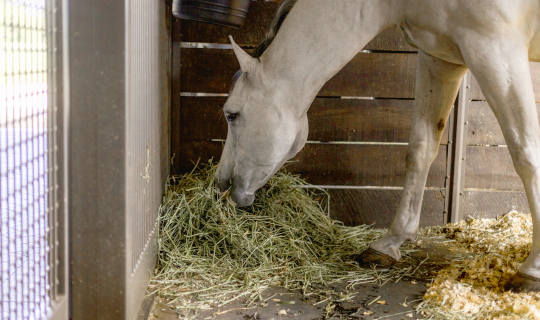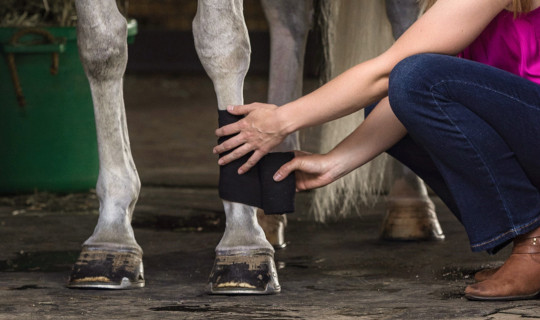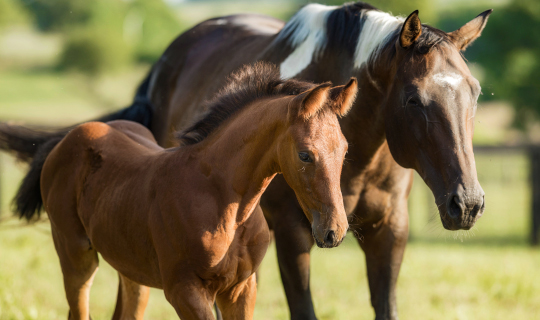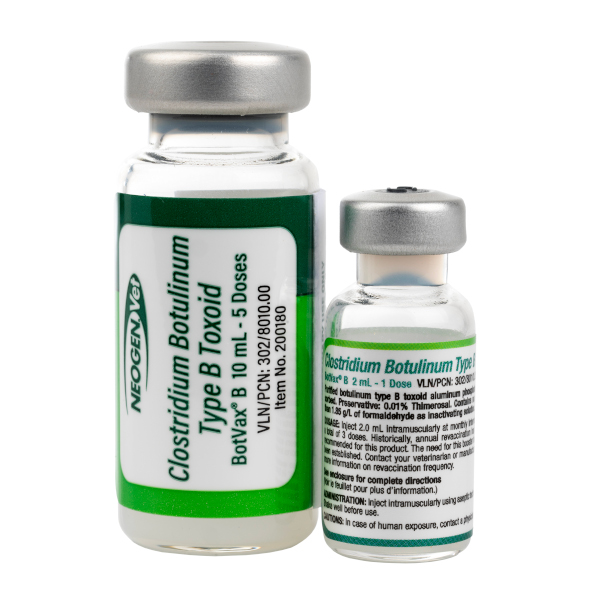
Clostridium botulinum
DEADLY, DANGEROUS, AND DIFFICULT TO DETECT.
Botulism neurotoxin is the most potent substance in the world.
This deadly, naturally occurring neurotoxin, can be found in feed, forage, and soil, posing a grave danger to horses of all ages. Produced by the anaerobic bacterium Clostridium botulinum, the smallest amount of neurotoxin can cause fatal neurologic disease in horses.
This lethal neurotoxin can be very difficult to detect—vaccination is the most important means of prevention against type B equine botulism the most common form of botulism to affect horses.
What is equine botulism?
Equine botulism is a progressive neuromuscular disease that quickly leads to weakness and flaccid paralysis, which is a lack of muscle tone with reduced ability to move. This paralysis leads to clinical signs including decreased eye tone, inability to swallow, and inability to stand. Clinical signs can progress over hours to days until death by respiratory failure. Horses can acquire botulism in a variety of ways, including ingestion of a preformed toxin, wound botulism, and toxicoinfectious botulism also known as Shaker Foal Syndrome.
Equine botulism is difficult to diagnose because its clinical signs mirror other diseases. Current diagnostic procedures for the disease are lengthy and can be inconclusive. Reduced eye tone, tongue tone and dysphagia (difficulty swallowing) are the most common early clinical signs.
What causes it?
The disease is caused by botulinum toxin, which is a dangerous protein produced by the Gram-positive anaerobe, Clostridium botulinum. The spore forming bacterium dwells naturally throughout the environment and is commonly found in soils across the country and around the world. When Clostridium botulinum spores encounter conditions for growth such as, the warm anaerobic environment in spoiling feed and forage, these bacteria start producing neurotoxin. Preformed odorless, colorless, and tasteless neurotoxin can persist in feed and forage throughout storage until the horse consumes it and develops clinical signs of botulism.
How do horses get it?

Feed & Forage — While typically called forage poisoning Botulism can occur after ingestion of any feed stuff. Horses can ingest preformed toxin by consuming improperly dried, processed, or stored forages and feeds such as hay, hay cubes, pelleted feeds, grains, and horse treats.
Botulism cannot be seen or smelled so even if hay is initially of high quality, improper storage conditions such as dampness or prolonged storage in warm, oxygen-deprived environments can promote the growth of Clostridium botulinum bacteria and production of toxin. High-quality hay can inadvertently contain decomposing organic matter where Clostridium botulinum bacteria may thrive and produce toxin.

Wound Botulism — Since the spores are ubiquitous, every wound exposed to dirt or dust can be contaminated by Clostridium botulinum. Wounds that develop conditions for growth, allow for the bacteria to begin producing toxin. Most commonly infected wounds include injection site abscesses, umbilical infections, puncture wounds and castration sites.

Toxicoinfections — Toxicoinfectious botulism, also known as Shaker Foal Syndrome, sporadically affects foals from a few days old to several months of age (70% of cases occur between two and five weeks of age). Soil-borne Clostridium botulinum spores are ingested by the foal, infect the gastrointestinal tract, and locally produce type B botulinum toxin that the foal absorbs systemically. It is important to note, this type of intoxication is not from eating hay.
Can botulism be prevented?
The only approved prevention for type B equine botulism is vaccination with Clostridium Botulinum Type B Toxoid (Neogen® Botvax® B.)
It is safe to administer to healthy adult horses, pregnant mares, and foals two weeks of age and older and protects against all modes of equine botulism type B including forage poisoning, Shaker Foal Syndrome and Wound botulism.
While good management practices including careful attention to processing and storage of feedstuff is important, it’s impossible to recognize a potential contaminated feed or forage on the farm due to the microscopic amounts of toxin required for a lethal dose.
Our goal is to provide horse owners, veterinarians, horse enthusiasts, industry officials, and the public with all the information available on this deadly disease so the best choices can be made for the animals we care for. Please contact your veterinarian to discuss the use of Botvax B for your horse.

Neogen® BotVax® Type B Toxoid Vaccine
Educational opportunities are available for veterinary practices, equine facilities and equine related events. Please contact us to learn more.

